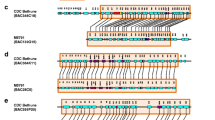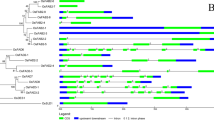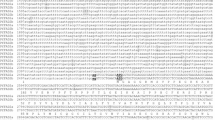Abstract
Increased levels of oleic acid may enhance the nutritional and functional value of corn. Corn oil is primarily composed of palmitic, stearic, oleic, linoleic and linolenic fatty acids. Delta-12 desaturase in plants converts oleic acid (18:1) to linoleic acid (18:2) by inserting a double bond at the delta-12 position. Fatty acid desaturase-2 (fad2) encodes delta-12 desaturase that functions in the endoplasmic reticulum while fatty acid desaturase-6 (fad6) encodes delta-12 desaturase that functions in plastids. Complementary DNA (cDNA) clones from putative maize homologs for fad2 and fad6 were identified and the entire clones DNA sequenced. The maize fad2 cDNAs showed an amino-acid identity of 67–77% to fad2 of Glycine, Arabidopsis and Brassica species. Our cDNA sequence comparisons suggested that more than one fad2 gene is transcribed in maize embryos. Two different fad2 cDNAs from an embryo cDNA library map to separate chromosomal positions, providing evidence consistent with two different isoforms of fad2 expressed in the embryo. The fad2 cDNAs from multiple tissue sources clustered into three groups on a phenogram, and map to different positions on chromosomes 4, 5 and 10, which suggests at least three different isoforms of fad2 may be expressed in the maize plant. The two maize fad6 cDNAs share 81% amino-acid identity with the Arabidopsis fad6 and map to chromosome 1. Northern analysis revealed that fad2 is transcribed in embryos at 14, 21, 28 and 35 days after pollination, with the highest level observed at day 14. None of the fad2 or fad6 clones mapped to maize chromosome bins associated with QTLs for the ratio of oleic/linoleic acid, notably bin 6.04 which contains the linoleic1 locus and the largest reported QTL for the oleic/linoleic ratio. This suggests, but does not prove, that some of the QTLs for the oleic/linoleic acid ratio do not involve allelic variants of fad2 or fad6 but rather involve other genes that may influence flux through the enzymes encoded by fad2 or fad6.



Similar content being viewed by others
References
Alrefai R, Berke TG, Rocheford TR (1995) Quantitative trait locus analysis of fatty acid concentrations in maize. Genome 38:894–901
Altschul SF, Thomas L, Madden, Alejandro A, Schaffer, Jinghui Zhang, Zheng Zhang, Webb Miller, Lipman DJ (1997) Gapped BLAST and PSI-BLAST: a new generation of protein database search programs. Nucleic Acids Res 25:3389–3402
Berke TG, Rocheford TR (1995) Quantitative trait loci for flowering, plant and ear height and kernel traits in maize. Crop Sci 35:1542–1549
Browse JaCS (1991) Glycerolipid metabolism: biochemistry and regulation. Annu Rev Plant Physiol Plant Mol Biol 42:467–506
Burr B, Burr FA (1991) Recombinant inbreds for molecular mapping in maize – theoretical and practical considerations. Trends Genet 7:55–60
Byrum JR, Kinney AJ, Stecca KL, Grace DJ, Diers BW (1997) Alteration of the omega-3 fatty acid desaturase gene is associated with reduced linolenic acid in the A5 soybean genotype. Theor Appl Genet 94:356–359
Chomczynski PaS, Chomczynski N (1987) Single-step Method of RNA isolation by acid guanidium thicyanate-phenol-chloroform extraction. Anal Biochem 162:156–159
Felsenstein J (1989) PHYLIP – Phylogeny Inference Package (Version 3.2). Cladistics 5:164–166
Harwood JL (1997) Plant lipid metabolism. In: Dey PM, Harborne JB (eds) Plant biochemistry. Academic Press, pp 237–272
Helentjaris T (1995) Atlas of duplicated sequences. Maize Genet Coop Newslett 69:67–81
Heppard EP, Kinney AJ, Stecca KL, Miao G-H (1996) Developmental and growth temperature regulation of two different microsomal omega-6 desaturase genes in soybeans. Plant Physiol 110:311–319
Higgins DG, Bleasby AJ, Fuchs R (1992) CLUSTAL V: improved software for multiple sequence alignment. CABIOS 8:189–191
Huang XM, Huang W (1991) A time-efficient, linear-space local similarity algorithm. Adv Appl Math 12:337–357
Jellum MD (1966) Fatty acid composition of corn oil of parental inbreds and reciprocal crosses. J Hered 57:243–244
King JJ, Hotchkiss JR, Rocheford TR (1997) Proc 33rd Annual Illinois Corn Breeders School. Champaign Itllinois March 3–4, pp 24–55
Lander ES, Green P, Abrahamson J, Barlow A, Daley MJ, Lincoln SE, Newburg L (1987) MAPMAKER: an interacative computer package for constructing primary genetic linkage maps of experimental and natural populations. Genomics 1:174–183
Mattson FR, Grundy SM (1985) J Lipid Res 26:194
Maniatis T, Fritsch EF, Sambrook J (1985) Molecular cloning, a laboratory manual. Cold Spring Harbour Laboratory. Cold Spring Harbour, New York
Mikkilineni V (1997) Restriction fragment length polymorphism analysis of the Illinois Long-term selection chemical strains, crop sciences. University of Illinois, Urbana, pp 107–113
Moore G (1995) Cereal genome evolution: pastoral pursuits with lego genomes. Curr Opin Genet Dev 5:717–724
Moore G, Foote T, Helentjaris T, Devos K, Kurata N, Gale M (1995) Was there a single ancestral cereal chromosome? Trends Genet 11:81–82
Ohlrogge JB, Jaworski JG (1997) Regulation of fatty acid synthesis. Ann Rev Plant Physiol Plant Mol Biol 48:109–136
Ohlrogge JB, Browse J, Somerville CR (1991) The genetics of plant lipids. Biochim Biophys Acta 1082
Ohlrogge JB, Jaworski JB, Post-Beittenmiller D (1993) De novo fatty acid biosynthesis. In Lipid metablolism in plants. CRC Press, Boca Raton, Florida pp 3–32
Okuley J, Lightner J, Feldmann K, Yadav N, Lark E, Browse J (1994) Arabidopsis FAD2 gene encodes the enzyme that is essential for polyunsaturated lipid synthesis. Plant Cell 6:147–158
Paul C, Naidoo G, Forbes A, Mikkilinenini V, White D, Rocheford T (2003) Quantitative trait loci for low aflatoxin production in two related maize populations. Theor Appl Genet (in press)
Plewa MJ, Plewa DFW (1975) Monosomic analysis of fatty acid composition in embryo lipids of Zea mays L. Genetics 277–286
Poneleit CG (1976) Chromosome location for control of oleic and linoleic acids in corn oil. Agron Abs 8:59
Poneleit CG, Alexander DE (1965) Inheritance of linoleic and oleic acids in maize. Science 1585–1586
Roche IA de la, Alexander DE, Weber EJ (1971) Inheritance of Oleic and Linoleic acids in Zea mays L. Crop Sci 11:856–859
Scheffler JA, Schimdt H, Sperling P, Parkin IAP, Luhs W, Lydiate DJ, Heinz E (1997) Desaturase multigene families of Brassica napus arose through genome duplication. Theor Appl Genet 94:583–591
Shadley JD, Shadley DFW (1980) Identification of a factor in maize that increase embryo fatty acid unsaturation by trisomic and B-A translocation analysis. Can J Genet Cytol 11–19
Somerville C, Browse J (1996) Dissecting desaturation: plants prove advantageous. Trends Cell Biol 6:148–153
Stam P (1993) Construction of integrated genetic linkage maps by means of a new computer package – JoinMap. Plant J 3:739–744
Stam P, Van Ooijen JW (1995) JoinMap (tm) version 2.0: software for the calculation of genetic linkage maps. Centre for Plant Breeding and Reproduction Research, Wageningen, The Netherlands
Thompson JD, Thompson HDG, Gibson TJ (1994) CLUSTAL W: improving the sensitivity of progressive multiple sequence alignment through sequence weighting, position-specific gap penalties and weight matrix choice. Nucleic Acids Res 22:4673–4680
Widstrom NW, Jellum MD (1984) Chromosomal location of genes controlling oleic and linoleic acid composition in the germ oil of maize inbreds. Crop Sci 24:1113–1115
Wright A (1995) A gene conditioning high oleic maize oil, OLC 1. Maydica 40:85–88
Acknowledgements
We acknowledge Dr. Tim Helentjaris for assistance and advice in the identification and use of fad2 and fad6 cDNAs from Pioneer Hi-Bred International cDNA libraries. The cDNAs evaluated in this study were provided by Pioneer Hi-Bred International. Some of this work was performed while T.R.R was on sabbatical in the Cereals Department, John Innes Centre, Norwich, U.K. We acknowledge the assistance of Gordon Huestis in mapping some cDNAs while working with T.R.R at the John Innes Centre. This research was supported by a grant from the Illinois-Missouri Biotechnology Alliance Program (USDA), and facilitated by gift support from Monsanto and Pioneer Hi-Bred International.
Author information
Authors and Affiliations
Corresponding author
Additional information
Communicated by F. Salamini
Rights and permissions
About this article
Cite this article
Mikkilineni, V., Rocheford, T.R. Sequence variation and genomic organization of fatty acid desaturase-2 (fad2) and fatty acid desaturase-6 (fad6) cDNAs in maize. Theor Appl Genet 106, 1326–1332 (2003). https://doi.org/10.1007/s00122-003-1190-7
Received:
Accepted:
Published:
Issue Date:
DOI: https://doi.org/10.1007/s00122-003-1190-7




